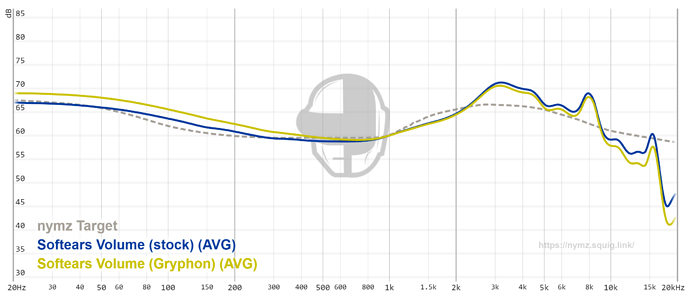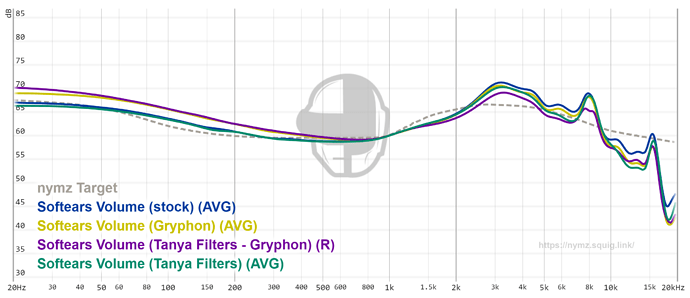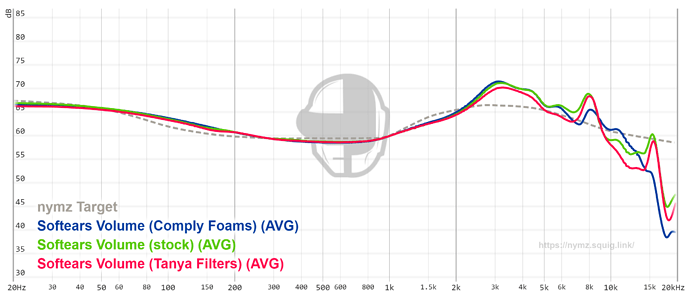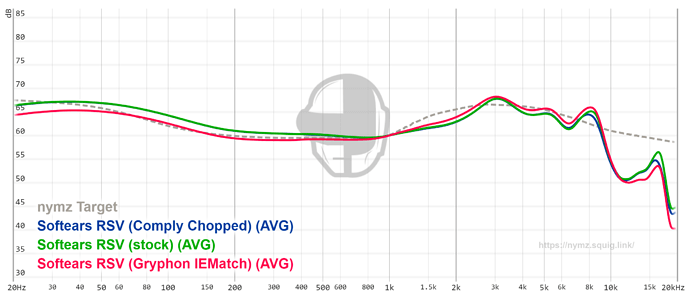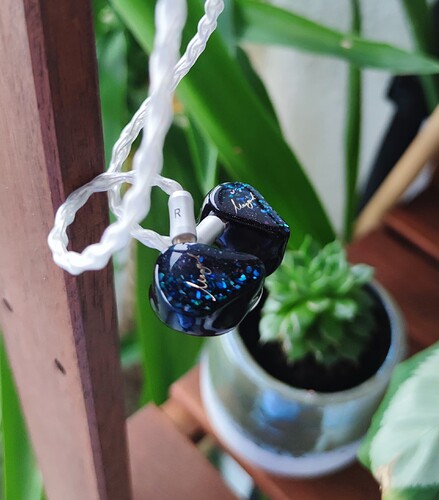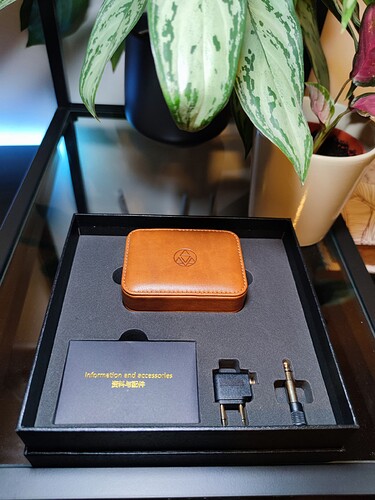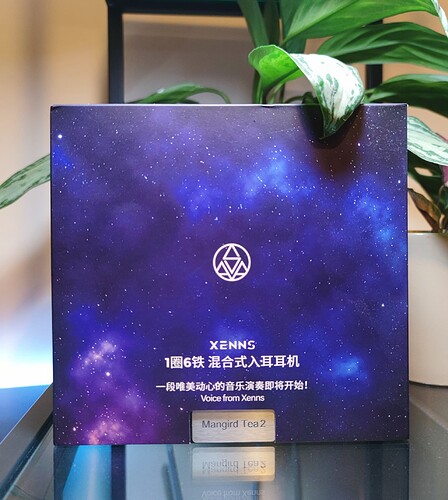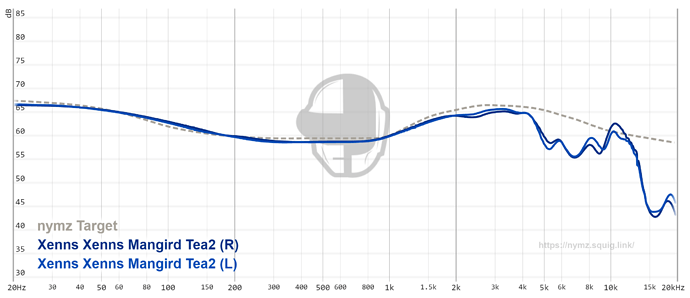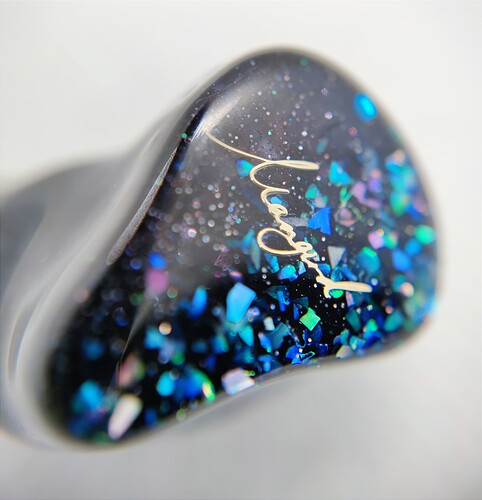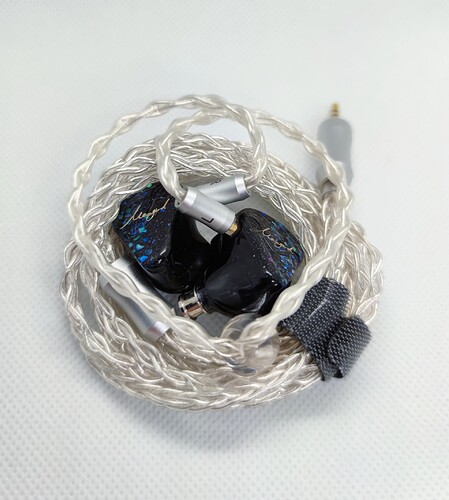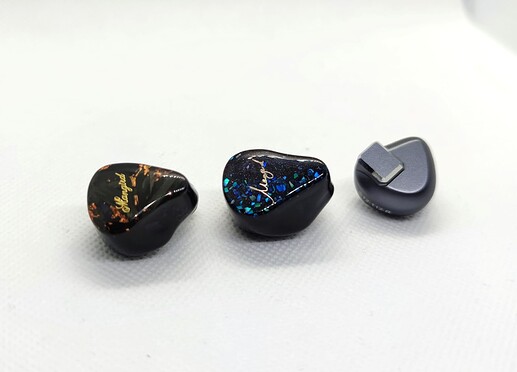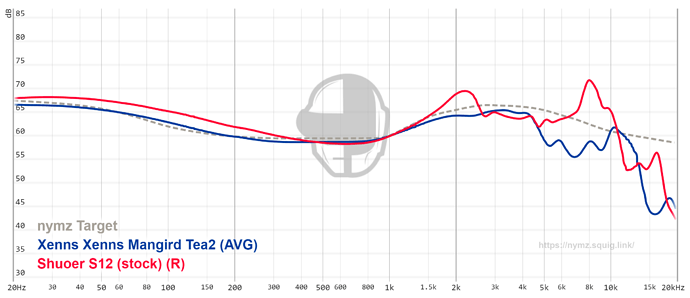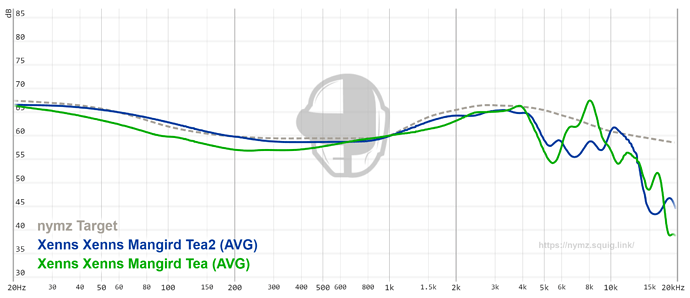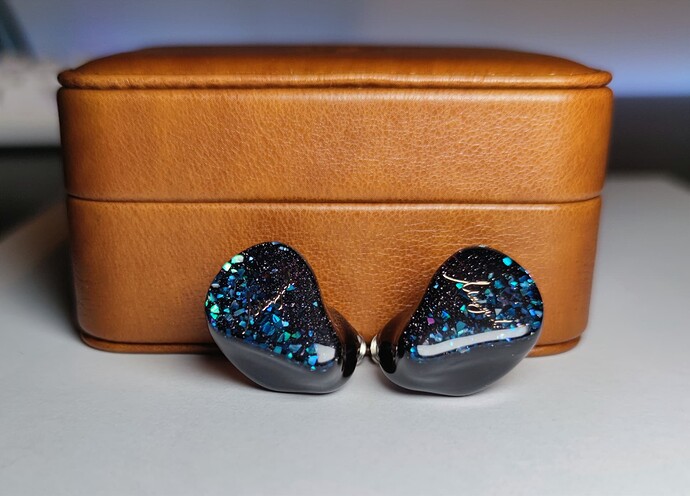nymz: * China PTSD flashback *
wait now there is coupler variaton ![]()
Measuring couplers response on one rig with fixed source - that’s a next level niche in this hobby… But honestly that would be somehow fun if someone would agree with Crin, HBB, precog and all whales to measure their equipment and how do they vary and how it impacts the perspective.
Or probably not THAT lot of fun ![]()
Joseph confirmed it’s KL graph. Makes sense because ej07m has usually a tucked in mid bass and KL has a slight engage through the mid range. It’s really a coupler difference, it seems. I will be able to graph and hear them this week so, it’s all good!
I will only be able to hear EJ07m on tuesday and compare ![]()
Everything matters, everything is a variable. Stock is NX7.
This is all done with silicone stock tips… Once I change tips, different results will show. Like:
That is a huge difference between sources especially in my opinion. Did you remove the bud from the coupler while changing NX7 → Gryphon or just replug the jack? I guess it is normalized at 1kHz?
I didnt. It’s due to Volume stupid sensitivity. Sources with higher OI will increase its bass.
Those are all normalized at 1k and i try to always align my measures with 8k peak.
Speaking of high end audiophile DAPs I am testing new german ALBI DAP with my daughter this weekend.
I can tell you it has nice grainy warm signature and opens up the stage very wide. Look is very modern and shape is practical, but the materials are cheap, battery sucks and lack of screen is a problem partially forgiven for informative LEDs
Here is the picture:
But joking aside it really plays wave files and mp3s from micro SD and deserted on an island with it I could use it with only a little ear bleed
Do you have cross measurements NX7/gryphon from anything else (more predictable than Volume) to see how that looks? Also what DAC do you use with NX7?
I tried with Tea, tea2 and Ejs. All the same.
Dac is a ddhifi dongle.
i trust your first impresions, if the discount is suficient ill pull the trigger
Can you wait til tuesday night? I will have ej07m by then!
asuming discounts last till then, sure
Then QC strikes and they are all different somehow anyway lol.
There are too many variables to be 100% certain but a cross section of grapher dudes results should give you a good idea of a sets FQ response but at the end of the day graphs don’t tell the whole story so ![]()
Xenns Mangird Tea2: The cult sucessor
Disclaimer: This unit was sent to me, for free, by Linsoul. No incentives were given for me to say anything about the set, so what you are about to read are my own thoughts and opinions. I would like to thank everyone at Linsoul for this opportunity.
Disclaimer no. 2: Everyone knows how I feel about Mangird Tea, but I will try to leave these feelings at the door. What you’ll read from below is not “nymz, the CEO” but Ricardo, a customer just like any of you, but in the role of a reviewer. I don’t have or never had any type of affiliation or monetary benefits regarding Teas. I will be as honest as I possibly can, and as unbiased as I’m able to be, but we are all still human beings.
Price: 349 USD
Driver Composition: 1 Dynamic Driver + 6 Balanced Armateurs
Shopping link: Linsoul
The prologue: History of Mangird Tea
Anyone that has been around for a while and looked for any IEM around the 300 dollars price range has probably come across Mangird Tea, a balanced but dark hybrid that was somewhat polarizing amongst the crowds. Despite Mangird being somewhat unknown, some folks got their hands on a set of Teas and they were later made well known by a YouTube channel called Bad Guy Good Audio Reviews (BGGAR for short). Months passed and Mangird Tea kept gaining some fans, turning into somewhat a cult following.
Tuning wise, Mangird Tea is not a (most) people pleaser, per se. Most won’t hate it, but it’s very balanced and has a dark treble. That is one of the reasons a lot of people love it as well. Despite its confusing graph, Teas are like sleepers, and every frequency just shows when it’s called. It’s the definition of an all-rounder that combines everything into one, no matter what you throw at it. It clearly showed that their tuner is smart, keeping everything at a balanced that would strike as something else than it looks like: BA timbre hidden due to treble recession, mid-bass slam despite looking bass anemic, sub-bass greatness even though it’s not that elevated, etc.
This type of tuning also helps with the perception of its real technicalities: Good stage, great imaging, very dynamic, coherent, great separation and resolving for the price, carrying its weight and punching above its own tag.
Months later Mangird changed its name to Xenns and introduced UP to the world: A tribrid with a beryllium coated DD and a warmer graph - promising upgrade, right?
As human nature is made of expectations, everyone expected a Mangird Tea V2, but with ESTs and even better techs and tuning. As with most things in life, expectations turned into deceptions despite UP’s performance, mostly because people were expecting something else.
I was one of the lucky to have heard both. Xenns UP is a different breed and one of those IEMs that is very hard to describe. It’s the warmest set I’ve heard to date, but despite that, Mangird brilliance strikes again and once it struck me, I couldn’t unsee it: They used beryllium coated drivers to still push some sense of tactile punch into the bass, making it kick like a mule above all the warmth displayed. This trick was also applied to the treble, but by using ESTs drivers - treble could still be slightly boosted, picking up detail and giving it air for its presentation.
You can now see how expectation felt short: from a balanced and semi-accurate replay into a colored replay was a huge road to cross, and people weren’t all that excited for that.
The present: Tea2
Later this January, out of nowhere, a new product was announced with a mouth full name: Xenns Mangird Tea Mk2.
Hype was back. A successor arrived, looking great outside, but what about the performance?
I’ve spent the last month using Tea2 most of my day while working or commuting. I have to admit it has been a surprising ride.
Packaging and non-sound characteristics
Tea MK2 comes in a sleeved cardboard box, well packed, which also contains:
- A 2-pin silver cable, terminated with a termination of your choosing - I got a 2.5mm;
- 6 pairs of silicone tips - 3 starline, 3 narrow bores - Same as last versions of UP;
- A rectangular, fake-leather carrying case - Same as OG/UP;
- An airplane adapter;
- Warranty and manuals.
The monitor’s shell is bigger than the original, but not by much, reminding me of Xenns UP or Yanyin Aladdin. These pseudo custom shells get me very good isolation, which made them a great companion for commuting. They fit deep and the nozzle has average width, causing no hotspots.
Stock cable feels fine, as it is the same as seen in the other Xenns’ offers, there’s no need for change.
Regarding tips, for silicone I used BGVP W01 (Large) for all my impressions. They gave me the best fit while keeping the sound balanced.
As for driveability, they are very easy to drive. For this review, all types of sources were used, such as: iFi xDSD Gryphon with IEMatch on, Cayin N3 Pro on Solid State mode, Quedelix 5k on performance mode and Topping NX7 on negative gain.
Sound characteristics
Tuning
The bass has extension, texture and is very fast. Tea2 got a crossover revision from its predecessor according to product pages, stating that these came down in the frequency, as seen on newer releases like Monarch Mk2, where the DD handles the lower frequencies and the mid-bass is mostly done with a Balanced Armature. The speed is very noticeable while still retaining some punchy slam to it, which I appreciate, but it won’t be as much as a slam dunk machine.
The sub-bass kept the first version’s DNA: it’s rumbly, has texture and extension, and goes deep (as seen on Hyper - Fckd,Trentemoller - Chameleon, Hans Zimmer - Why So Serious?, Jamie XX - Gosh).
The mid-bass now has more elevation and presence, while also adding a tiny bit of warmth and weight. (Foo Fighters - Waiting On a War, KH - Only Human, Radiohead - Packt Like Sardines in a Crushd Tin Box, Marco Carola - Play it Loud, Jungle - The Heat [Joy Orbison Remix]).
This bass shelf also helps to give body to the mid-range, but without bleeding into them, as the dive is very clean, enough to not feel thin, but also just enough to not make the notes blurred or too heavy. As per usual in these types of tuning and following the same pedigree of the Mangird Tea, Tea2’s mids are very forward, with details (Hania Rani - Glass, EWF - September, Nils Frahm - My Friend The Forest) on point and together with the techs that I will talk about in a bit. They give a very curious sound presentation.
Regarding upper mid-range/vocals, they are just to die for. They feel organic, natural, and have note weight to it without ever coming out as thin or lacking bite, but still never as shouty (Agnes Obel - Curse, JP Saxe ft. Julia Michaels - If The World Was Ending, Postmodern Jukebox - Can’t Feel My Face). They are full of details and have a great timbre, treating reverb and back vocals like not most sets do, while keeping the gain at a slightly below average dB level that most offers in the market do.
Overall, the mid-range is clearly the main event of the set. There’s a clear feel of separation between it and the other frequencies, in a good way. For people that prefer mids over anything on their spectrum, this is just a wonderland.
Treble kept the same recipe that won my preference over and over again: a dip around the 5-6k area, which I’m personally sensitive to, just enough to reduce the fatigue and increase the forgiveness of the tracks. This was done on some of my favorite sets like the Shuoer EJ07 or Mangird Tea.
Cymbal strikes and electric guitars still sound great (Iggy Pop - Lust For Life, Cory Henry - Seven, Joe Satriani - Snatch Boogie), of course losing on timbre departments to other offers like single DD sets, but that will always be the trade-off with hybrid sets.
The extension got a boost which most will find welcoming and airy, without interfering with other frequencies. This is one of my favorite implementations up to this price point, but still no good EST extension, which is found in another price point.
To summarize, I think the tuning in Tea2 is spot on and won’t have much fault to it, pleasing pretty much everybody and doing nothing wrong.
Technicalities
Stage is my favorite part of this set. It was the first thing I noticed when I tried the IEMs, but is also one of the hardest characteristics to describe, which I will now try the best I can:
It is wide, has depth and very good height. It’s not just big, but it is very holographic. I will even double down: It’s one of the most holographic and beautiful stage presentations I have ever heard.
Vocalists get positioned a step back, reminiscent of Xenns UP presentation by memory, while the rest of the replay happens around you, as if you were in the middle of a jam, a feature that reminds of Shuoer’s EJ07m. This also works very well with vocaless genres like pure electronic or even jazz/classical, as you can just appreciate sounds one by one. A delight to get lost in.
Example Tracks: Yosi Horikawa - Bubbles/Crossing, Tool - Fear Innocolum, O’Flynn - Tyrion, Lykke Li - Silent My Song, Jamie XX - Gosh, Agnes Obel - The Curse.
Imaging is very good; you can almost pin-point every drum-roll or sound in the spectrum. It’s not on tribrid level, but it’s close. It gets you through the stage without much effort, not ever feeling blurry or confusing you. Combining this with this set’s separation and holographic stage, you just get immersed by sound walls around you.
Example Tracks: Yosi Horikawa - Bubbles/Letter, Tool - Fear Innocolum.
Details are still very good, even though it has (almost) no tuning help. Of course, some other tunings or drivers will come out as more detailed if you microscope it. But as for the overall clarity, it’s crystal clear. I have to disclose they are still a half-step back from other sets that are at more expensive price brackets, but for what it provides and no treble boost, I’d approve over and over again.
Example tracks: Hania Rani - Glass/Esja, Ozy Ozborne - Dee, Nils Frahm - Says/All Melody, Larnel Lewis - Forgotten Ones.
Dynamics are good, low to high without any effort or discomfort. The left to right pans are very good and the speed is insane.
Example tracks: Mia Dora - After the Dog, Lorde - 400 Lux, Avenged Sevenfold - Bat Country, Jason Richardson - Titan/Hos Down, Disclosure - ENERGY.
Timbre is, in my opinion, the weakest point of Tea2 technicalities, not because they are bad per se, but due to driver configuration, it will lose to most single DD sets. I don’t find the usual plasticity of the BA timbre that is common, but rather the faster decay shown in the bass. This could be a pro or con, depending on your library.
To note that this varies more from set to set than just driver configuration: Tea2 has superb timbre if compared to a single DD like FDX1 with its metallic timbre.
Test Tracks
Here I will comment on some tracks I think that really shine on Mangird Tea2:
Lorde - Team
Dead-clean detailed intro, building up for the 0:26 drop where the kick drum sample shows itself with texture and speed. You can clearly hear its decay movement with detail behind the vocals, at the same time the claps start to mark up the tempo in the back lines, with a nice detailed echo effect. All this takes place while Lorde’s voice sounds detailed, with a nice timbre and weight without ever becoming shouty or distorted. When her own back vocals appear, the Tea2 just place them in another place, so you clearly know the scene has changed. A treat to listen to, not just this track but in fact the whole album.
O’Flynn - Tyrion
This groovy underground and jungly house track is a perfect example of what Tea2 does best. Any groovy track just gets even more groovy, as if the set was a chameleon to the genres due to its tuning.
All the percussion can be pinpointed due to its imaging throughout the track. Around 2:33 it comes closer and closer from the far back, while the volume also goes up, which Tea2 proceeds to show it’s great stage and dynamics effortlessly. After that, even when things get busier, the separation still holds and shifts panes very fast. Every touch has its texture if you listen closely. A great production replayed by a great set.
Radiohead - Packt Like Sardines In A Crushd Tin Box
A great “classic” from a great album. Bass extension on point without ever changing its presence level or texture. The separation just makes everything crystal clear until Tom Yorke’s voice shows up, in a mellow theme, not overly emphasized or husky, in front of you, while other instruments and samples surround your room. At around 2:08 there’s a very subtle reverb/echo effect on his voice that Tea2 is able to pick it up and bring it in front, which once again shows how much this set likes voice effects.
Ely Bruna - I Like Chopin
Right from the start, Tea2 showed how great for pianos they are (see Nils Frahm or Hania Rani albums as well), but it was Ely’s voice that hooked me up. There’s some very subtle cymbals in the back, just as if there were rain decaying to the beat of this mellowy and slow song. You can clearly hear her raspiness and throat details on a beautiful timbre without masking the other instruments.
Jungle - The Heat (Joy Orbison Remix)
Dark. Hard. Methodic. That’s how the intro starts, and sirens firing off, out of nowhere, proving once again the stage is a bliss around you. Everything keeps getting thrown from nowhere and the vocals shine in. But it’s at 2:36 where the bass drops that the magic happens. Great texture and subtle rumbles while the higher frequencies keep you focused and in sync with the vocals. Makes you wanna go into an underground party and hug the speakers. Lovely.
Little Tempo - Mountain and Sea
Dub-dub-dub. Mids on your face, kicks on your chest, everything around you. Not much explanation needed. Tea2 takes me back to the sunny summer holidays. Whole album is great.
Kindness - Gee Up (Erol Alkan’s Extended Rework)
Impactful kick drum intro with a clear snare and defined vocals build you up for some sweet and simple electric guitar chords, without any harshness or fadeouts. The back vocals are clearly defined and follow the stage around, up to the main event around 2:41 where everything gets loose. You can clearly separate all the information and pinpoint where they’re coming from. They are literally, everywhere. Around 3:15 you have a bass guitar that has the right elevation - not pushed too in the back and not too in front, just right. That gets followed by great detailed cymbals into a dip of the song where, once again, reverbs and echos of claps chime in, impactful and treated the right way.
Listening on the Tea2 was one of my favorite replays of this song so far. It just makes me happy.
Other Tracks
I will leave here a playlist of songs I think Tea2 replayed very well and that I also used for this review, for you guys to listen and jam to. As stated, I spent a lot of time with this set and not everything could be fitted in here (Tidal).
Comparisons
LETSHUOER S12 (with Final E)
Shuoer’s planar immediately comes out as a different beast to the Tea2 set. Despite the tuning differences, Tea2 instantly shows more clarity.
Bass is more impactful on the Tea2, with better rumble and texture and decay. S12 bass is still faster, despite Tea2’s being already fast (maybe too fast though).
Mids are a bloodbath in Tea2’s favor as expected, given that S12 is a mild V-Shape to my ears which pushes back details and information. For those that don’t like forward mids, they are way less fatiguing.
Treble has more elevation and extension on S12, but comes out as more fatiguing and hotter than the Teas. Cymbals’ decay feels too fast and crisp, but very detailed nonetheless.
S12 stage is much smaller in every axis, missing that 3D factor and superior imaging.
It’s still very surprising how good S12 sounds for its price, that when it’s on sale, it’s almost a third of the price of the Tea Mk2, so there’s that in Shuoer’s favor. That sweet planar timbre that some love, including me.
Mangird Tea (with Radius Deep Mount)
Despite the graphs and the name, both iems behave differently, although sharing the same name and brand.
The biggest changes to my ears are the presentation and the mid-bass. Original Teas already had a wide stage with nice height and some depth, but the revision just expanded the last two while providing some holographic psychoacoustics.
The mid-bass is faster and tighter on Tea2 but there is more DD punch (slam) on the original Teas. To me this is basically explained by the new BA crossover, giving a feeling of OGs being more visceral.
The mids are very even and the best characteristic on both. It’s basically a draw minus the male vocals, where I think Tea2’s elevation comes out as the winner.
Treble is better refined and extended in the version 2, where the loss here for the OG also makes it more forgiving on tracks, even if both are. This is another area that I consider the driver upgrade made some impact, in a good way.
Stage, imaging, detail and separation are better on Tea2 in every way, mashing up into a more resolving IEM than its predecessor.
Overall, I feel Tea2 is more analytical and technically superior, where Tea mk1 is warmer with more note weight, more relaxed. The timbre and coherency are a hair better on the OG version also helped to less elevation, but that’s not something I feel most people would notice. Another thing to notice is that the Tea OG presentation is more forward and in your face, despite its slightly more relaxed overall tuning.
Shuoer EJ07m/EJ07m Kinda Lava (with BGVP W01)
Coming soon™
Conclusions
To me, there’s no doubt the revision of the Teas (i.e. the Tea Mk2) is superior to its predecessor in the technical departments. It’s very obvious that Xenns wanted to try to reach a bracket between the original Teas and Xenns UP, while trying to do something refreshing. To my eyes, they did it.
There’s an elephant in the room that I would like to address, and that is the price. Mk2 had a 50 dollars increase over the already 300 dollars Mangird Tea, which puts it in a more expensive bracket than some of its direct competition, which I’m not sure will entice people to buy it.
With that out of the way, Tea2 gets a big recommendation from me. It plays most of my library very well, it’s a great set to just grab and go due to its form factor and easy driveability, and the stage presentation is just lovely.
To Xenns, my sincere thanks for putting the Tea lineup out, as they were my first real love set in this hobby.
Tea Cult lives on.
Recommended. Value: 4.5/5 Ranking: A
Thanks for reading!
PS: Tea2 is on a bundle sale with a cable (Kinera Ace) up the 1st of April, in case you interested.
Have a nice week!
Best,
nymz, the Tea2 drinker
CEO of Buy Mangird Tea(2)
Amazing review ![]() Can’t wait for the comparisons to the 07Ms.
Can’t wait for the comparisons to the 07Ms.

